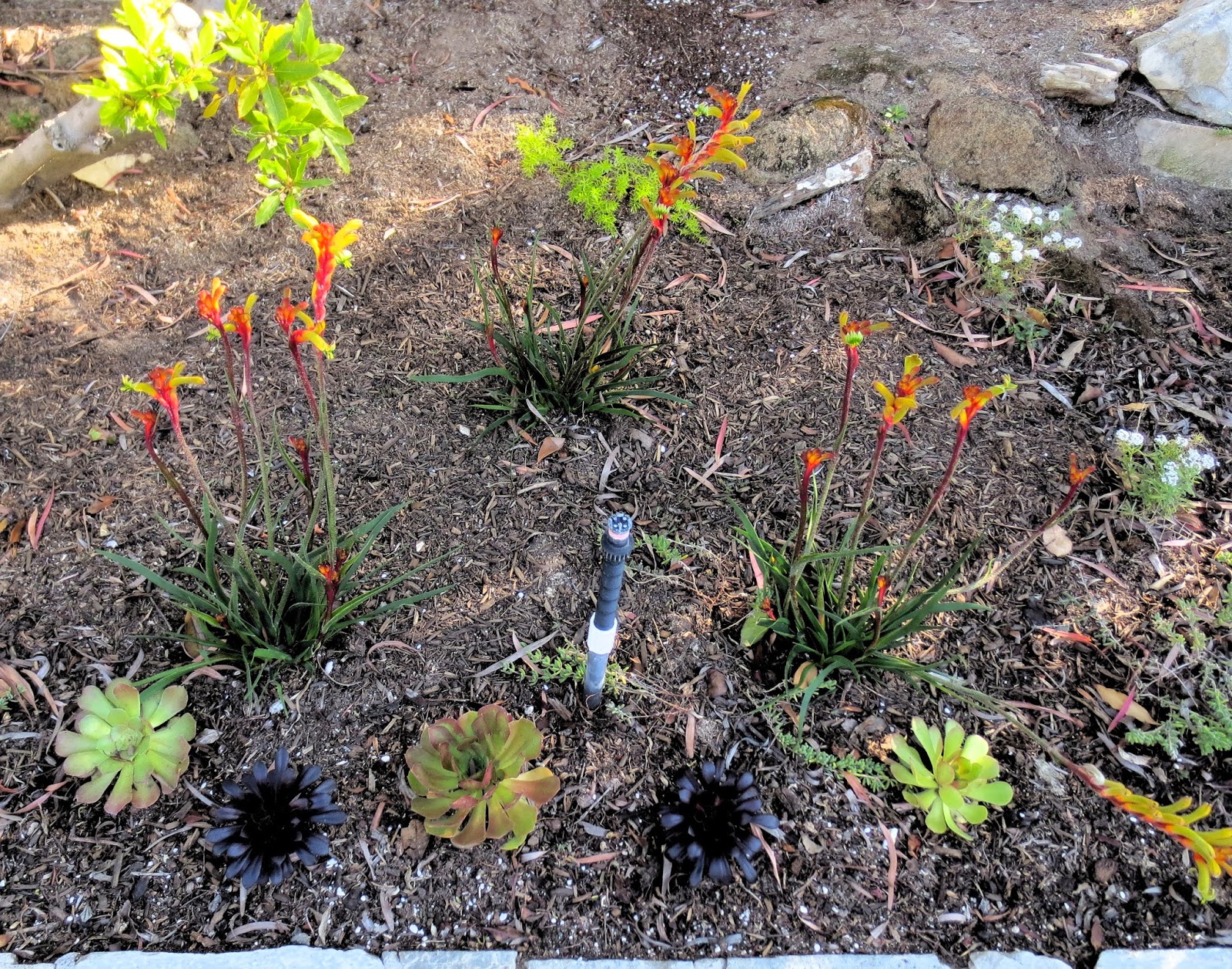 |
| 3 Anigozanthos 'JoeJoe Red' surrounded by Papaver nudicaule, Agonis flexuosa 'Nana,' Phormium 'Amazing Red,' and Crassula lycopodioides |
I also put 2 Anigozanthos 'JoeJoe Yellow' at the base of one of the raised planters in the vegetable garden. They seem to be adjusting well there too (although it looks as though I need to put out some snail bait.
More recently, I've added 3 taller Anigozanthos 'Bush Eternity' below the hedge along the street I pruned back within an inch of its life last month.
 |
| Anigozanthos 'Bush Eternity' in newly planted border in front of pruned hedge |
 |
| Close-up of flower on Anigozanthos 'Bush Eternity' |
The 'JoeJoe' varieties grow just 12-15 inches tall and wide (30.5-38.1cm), while 'Bush Eternity' is said to get 1-3 feet tall (30.5cm-1m). All do best in full sun with regular water and good drainage, although Kangaroo Paws can tolerate periods of drought. They hail from southwest Australia and the evergreen foliage grows from rhizomes. The sap in the root system reportedly supports survival during extreme dry spells. Some varieties can die back during the heat of summer but recover in the fall. They're suited to USDA zones 9a-11 (Sunset zones 15-24). Estimates of cold tolerance range from 20 to 30 degrees Fahrenheit (or -6.7 to -1.1 Celsius).
The sword-like dark green foliage of these plants is attractive in its own right but the plants are generally grown for their unusual flower spikes, which have a fuzzy texture rather like velvet. According to my references, they should bloom from late spring through fall; however, my oldest plant has bloomed continuously since I acquired it in September. I cut back the blooms as they fade and the plants pump out more spikes.
They attract hummingbirds and, if I was faster with my camera, I'd have pictures of a hummingbird drinking nectar from 'JoeJoe Red' to share here but I haven't succeeded in capturing that moment yet. Baiting for snails and slugs is recommended. In cool, moist climates they can be susceptible to a fungus that causes something known as ink disease but I haven't had a problem of this nature thus far. I've tried only the red and yellow flowering types but there are also pink and green varieties. Based on my initial success with the plants in my current garden, I'm tempted to try a pink variety, although no one I know locally has had luck with it.
The Anigozanthos hybrids are my choice as favorite plant this week. I'm joining Loree of danger garden in here meme celebrating favorite plants in her garden and those of other participating gardeners. You can find Loree's choice and other contributors' input here.

So pleased to see that they are finally doing so well for you! They are great plants with such exotic looking flowers.
ReplyDeleteThey are great plants. Now I just have to keep myself from going overboard with them...
DeleteI really wish they were hardy here, so I could grow them in the ground. I'm going to buy a couple to keep in pots this summer.
ReplyDeleteThe dwarf hybrids seem to be tougher than the taller varieties I formerly grew, Alison - you might want to try those to start.
DeleteI would love this plant for its name alone! I am glad you are having success with it. It would be an annual here, but I love its exotic, fuzzy look. Perhaps i could grow it in a pot.
ReplyDeleteThe name is surprisingly descriptive, Deb - the flowers are fuzzy and paw-shaped.
DeleteI love that you've gone from zero to eight (?) plants in such quick order. These are a huge fav of mine, even though it means buying a new plant or two every year. Oh how happy I would be in they were hardy...
ReplyDeleteYep, 8 plants and counting...
DeleteIsn't it wonderful to have a plant thrive when you've had failure before. Another one of your pretties that is completely new to me Kris. I can clearly see why you just had to have more!
ReplyDeleteI've been slowly trying again with many of the plants that failed in my old garden, Angie. Even though our current house is only 15 miles to the south (and technically in the same USDA climate zone), conditions are much different here. Of course, that also means that plants I succeeded in growing at the old place don't always make it here.
DeleteWhat beautiful colours! I think I will need to add more varieties to my garden.
ReplyDeleteThey seem to be breeding new colors, Amy, although, as is often the case, the really unusual ones are also very pricey.
DeleteThey are gorgeous, I love those fuzzy flowers. I suppose they would do well in a pot if they can cope so well with drought. How wonderful to have humming birds.
ReplyDeleteThe hummingbirds have a field day here, Chloris - there are plenty of flowers that fit their ample appetites. We have some that reside here and others that migrate through.
ReplyDelete